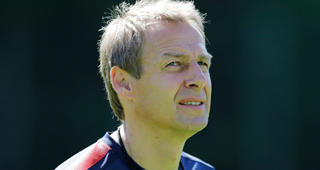It’s not clear what Jürgen Klinsmann is trying to accomplish. This is the most damning dimension of his disappointing five-year tenure as manager of the US Men’s National Team and de facto figurehead of the entire American soccer industrial complex. Under Klinsmann’s watch, the US have fluctuated between competence and losing to Guatemala, but worse than that, they have moved in no discernible direction, constantly shuttling players in and out of the squad, messing with different shapes and approaches, going young in one tournament and leaning on veterans the next.
When Klinsmann was hired in 2011, he claimed he would bring “a more proactive style of play” to America, in contrast to the grinding, deep-defending approach employed by his predecessors. Klinsmann wanted the US to play faster and press higher. He said American culture is brash, so our soccer should be as well, which is expert flattery but has never made sense as an informing principle. The US talent pool lacks for technical skill and is populated mostly with strong, bulldogish midfielders and quick forwards with cannon ball-heavy first touches. This is a problem, but it’s not unworkable. Klinsi has exacerbated the issue by, in the past, asking Michael Bradley to play like David Silva, and, more recently, trying to will a 4-3-3 into existence without having the necessary players for it.
The result of this dissonance between Klinsmann’s vision and the talent he has at his disposal is that the US frequently demonstrate no style at all. In a 2-0 Copa America loss to Colombia last Friday, the midfield trio of Bradley, Alejandro Bedoya and Jermaine Jones knocked the ball among themselves without impetus, the fullbacks didn’t provide width, and the front line—a second striker as a nine and two center forwards as quasi-wingers—appeared not to know what their jobs were. The most threatening moves the US produced were when either Bobby Wood or Gyasi Zardes dropped between the lines and received the ball... but then they would turn and frequently discover no one running into the spaces beyond them. The team’s performance was enough to make one wonder what Klinsmann is instructing his players to do. When the German puts his arm around Alejandro Bedoya in training, what ideas is he putting in the midfielder’s head?
This is important because soccer is a sport organized by ideas, the big and the specific. A team must have an overarching approach to the game—are they aggressive? possession-obsessed? patient? counterattacking?—and then, following from that, a more detailed plan as to how to achieve the style they set out to impose. Uruguay, for instance, aim to turn every match into a rumble. It’s an underdog’s gambit—it’s legible and it gives the players and fans an identity to rally around.
At the granular level, Óscar Tabárez asks his midfielders to break up play by any means necessary and make simple passes when in possession. Uruguay’s forwards are selfless; they make runs into whatever areas open up the most space and they harass teams that try to build from the back. The center backs have license to intervene and kill attacks before they happen, and, optimally, to skip the midfield altogether and play a ball directly into the path of an advancing striker. Uruguay’s big idea is that they want to create chaos and exhaust their opponents. They can’t hang with the world’s best on a technical level, but they can beat anybody in a fight.
The US aren’t trying to win in any particular fashion. They have a vague idea that they want to play fast, but they don’t execute it because they don’t have the talent and, more troublingly, it doesn’t appear Klinsmann is giving them any methods that would help them play fast. The US don’t press with any kind of organization; the midfield and the front line are often barely within shouting distance of each other; and Michael Bradley plays a lot of sideways passes because there aren’t other options available to him. You can’t transform a team simply by telling them what you want them to be. You need to show them how.
More troubling still is the fact that Klinsmann thinks the Colombia loss was a good performance, on the whole. He went as far as to call the match “totally even.” To a man, the squad echoed Klinsi’s sentiments, and USMNT optimists pointed to possession and chances created statistics. This ignores the reality that Colombia scored in the eighth minute and played conservatively from that point forward, contentedly giving the US possession in the middle of the pitch and not being bothered by anything other than a solitary Clint Dempsey free kick. It’s one thing to play mediocrely; it’s another to fool yourself into thinking you played well because you’re willfully misreading your opponent’s approach.
This US squad can and should make it out of their group. They’re better than Costa Rica and Paraguay, if not by a lot. But it’s hard to see the US Men’s National Team getting anywhere significant if Klinsmann isn’t going to offer more than undercooked strategery, rah-rah claptrap, and delusion. It’s true that the US want for great players and that building an infrastructure that identifies and properly trains talented youngsters is going to take much longer than five years, but Klinsmann—for whatever traits he possesses that keep him in the US Federation’s good graces—seems out of ideas, or perhaps never had any in the first place. Until the US start to make sense, they’ll struggle. A team without an identity can’t succeed.



